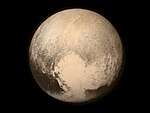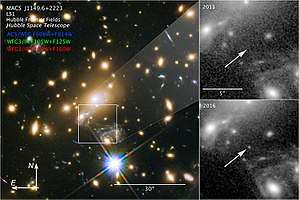2015 TH367
2015 TH367 is a trans-Neptunian object approximately 220 kilometers (140 miles) in diameter. It is currently outbound approximately 89 AU from the Sun,[7] a distance of more than 13 billion km (8.1 billion mi). As of its announcement in March 2018, it is the fourth most distant observed natural object in the Solar System. At a visual apparent magnitude of 26.2, it is one of the faintest trans-Neptunian objects observed.
| Discovery [1][2] | |
|---|---|
| Discovered by | D. J. Tholen S. S. Sheppard C. W. Trujillo |
| Discovery site | Mauna Kea Obs. |
| Discovery date | 13 October 2015 (first observed only) |
| Designations | |
| 2015 TH367 | |
| V774104? | |
| TNO [3] · SDO [4] distant [1] | |
| Orbital characteristics [3] | |
| Epoch 11 January 2016 (JD 2457398.5) | |
| Uncertainty parameter 9 | |
| Observation arc | 355 days |
| Aphelion | 136±121 AU |
| Perihelion | 29±6 AU |
| 83±73 AU | |
| Eccentricity | 0.65±0.39 |
| 751±1002 yr | |
| 59°±116° | |
| 0° 0m 4.716s / day | |
| Inclination | 10.99°±0.095°[lower-alpha 1] |
| 245.1°±0.2° | |
| 19°±35° | |
| Physical characteristics | |
Mean diameter | 211 km (estimate)[5] 220 km (est. at 0.09)[6] |
| 0.08 (assumed)[5] | |
| 26.2[2] | |
| 6.5899[3][1] | |
Discovery
2015 TH367 was first observed by Scott Sheppard, Chad Trujillo, and David Tholen on 13 October 2015 using the Subaru Telescope, a large reflecting telescope at the Mauna Kea Observatories on the summit of Mauna Kea with a primary mirror 8.2 meters (27 ft) in diameter.[2] In 2015 it was only observed for 26 days,[2] which is a very short observation arc for a trans-Neptunian object as objects far from the Sun move very slowly across the sky. It is calculated that it will remain in the constellation of Aries from 1994 until 2077. It was announced on 13 March 2018 alongside several other trans-Neptunian objects with a current heliocentric distance greater than 50 AU.[8] The trans-Neptunian objects 2015 TG387, 2015 TJ367, and V774104 were also discovered by this team on 13 October 2015.
Orbit
The orbit of 2015 TH367 is poorly constrained, as it has only been observed 8 times over less than 1 year due to how dim it is.[3] At a visual apparent magnitude of 26.2,[2] it is about 75 million times fainter than what can be seen with the naked eye,[lower-alpha 2] and it is one of the dimmest asteroids ever observed, only being able to be seen by the largest modern telescopes. It is estimated to have come to perihelion (closest approach to the Sun) around the year 1893±77.[3]
Distance from the Sun
The precise distance of 2015 TH367 still remains unknown due to its poorly understood orbit. It is currently outbound roughly 89±4 AU from the Sun,[7] and will require further observations to better refine the orbit. The object has not been observed since October 2016.[1] At magnitude 26, it is only observable with a small number of telescopes that are capable of following it up and refining its orbit. It is expected to come to opposition in the constellation of Aries around 3 November 2018 when it should have a solar elongation of roughly 175°.
There are only 4 known minor planets further from the Sun than 2015 TH367 under its nominal orbit as of March 2018, 2014 UZ224 (90.9 AU), Eris (96.1 AU), 2018 VG18 (123.8 AU), and "FarFarOut" (~140 AU).
Observed Solar System objects that periodically become more distant than 89 AU from the Sun include Sedna (which is much larger in size), 2000 CR105, 2012 DR30, 2013 BL76, and 2005 VX3. There are 804 known objects that have aphelia more than 89 AU from the Sun as of March 2018.[9] This distance is about double the outer limit of the torus-shaped Kuiper belt that lies outside Neptune's orbit. Far beyond this region is the vast spherical Oort cloud enshrouding the Solar System, whose presence was deduced from the orbits of long-period comets.
Another distant object publicly known as V774104 was purportedly discovered at around 103 AU on 13 October 2015 by the same team, but public press releases may have confused its distance with 2015 TG387 (V302126).[10][11]
Study of the population of Solar System objects that are significantly more distant than 2015 TH367 will likely require new instruments. The proposed Whipple spacecraft mission is designed to determine the outer limit of the Kuiper belt and directly detect Oort cloud objects out to 10,000 AU. Such objects are too small to detect with current telescopes except during stellar occultations. The proposal involves use of a wide field of view and rapid recording cadence to allow detection of many such events.[12]
Notes
- The orbital inclination is the easiest part of an orbit to determine.
- Math: 75,860,000
References
- "2015 TH367". Minor Planet Center. Archived from the original on 14 March 2018. Retrieved 22 March 2018.
- "MPEC 2018-E86 : 2015 TH367". Minor Planet Center. 13 March 2018. Retrieved 22 March 2018. (K15Ta7H)
- "JPL Small-Body Database Browser: (2015 TH367)" (2016-10-02 last obs.). Jet Propulsion Laboratory. Archived from the original on 14 March 2018. Retrieved 22 March 2018.
- "List Of Centaurs and Scattered-Disk Objects". Minor Planet Center. Retrieved 9 February 2018.
- Brown, Michael E. "How many dwarf planets are there in the outer solar system?". California Institute of Technology. Retrieved 9 February 2018.
- "Asteroid Size Estimator". CNEOS NASA/JPL. Retrieved 22 March 2018.
- JPL Horizons: 2015 TH367 (Soln.date: 2018-Mar-13)
Observer Location: @sun
Under "Table Settings" select "39. Range & range-rate". Uncertainty in distance (km) is RNG_3sigma - Bannister, Michele (12 March 2018). "Always fun seeing more distant d>50 au TNOs arrive..." Twitter.com. Retrieved 22 March 2018.
- "JPL Small-Body Database Search Engine: Q > 89 (AU)". JPL Solar System Dynamics. Retrieved 12 March 2018.
- Witze, Alexandra (10 November 2015). "Astronomers spy most distant Solar System object ever". Nature News. doi:10.1038/nature.2015.18770.
- Trujillo, Chadwick; et al. (2018). A New Inner Oort Cloud Object. 50th Annual Meeting of the Division for Planetary Sciences. 21-26 October 2018. Knoxville, Tennessee. Bibcode:2018DPS....5031109T.
- Alcock, Charles; et al. (19 December 2014). The Whipple Mission: Exploring the Oort Cloud and the Kuiper Belt (PDF). AGU Fall Meeting. 15-19 December 2014. San Francisco, California. American Geophysical Union. Bibcode:2014AGUFM.P51D3977A. P51D-3977. Archived from the original (PDF) on 17 November 2015.
External links
- List Of Centaurs and Scattered-Disk Objects by the Minor Planet Center
- 2015 TH367 at AstDyS-2, Asteroids—Dynamic Site
- 2015 TH367 at the JPL Small-Body Database




